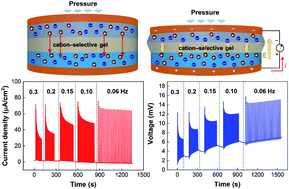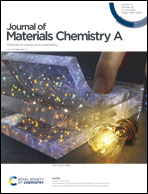Ion transport through layered hydrogels for low-frequency energy harvesting toward self-powered chemical systems†
Abstract
We developed an ionic energy harvester based on polymer hydrogels, which was designed to harvest low-frequency mechanical vibrations by taking advantage of the slow diffusion of ions. Our ionic devices are composed of three-layered polymer hydrogels with different stiffnesses and ion selectivities. Under mechanical compression, the inhomogeneous volume changes of the component hydrogels induced massive and directional ion transport, while the ion selectivities of the hydrogels allowed charge separation of the transporting ions into cations and anions through the stacked hydrogels. Consequently, an electric potential difference was built within the layered hydrogels, allowing the conversion of mechanical energy into electricity. This mechanical-to-electrical energy conversion was engineered under a number of experimental conditions. Under the optimized conditions, our hydrogel devices produced an open-circuit voltage of 12 mV and a short-circuit current density of 72.5 μA cm−2 at 0.008 Hz. We further demonstrated the synthesis of inorganic nanoparticles and energy generation from human walking by implanting the prepared ionic devices into a metal precursor solution and shoes, respectively. Collectively, this study provides a blueprint for the future development of hydrogel-based ionic energy harvesters as soft and flexible power sources for many self-powered systems.



 Please wait while we load your content...
Please wait while we load your content...